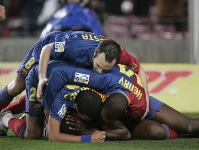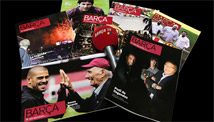FCBARCELONA.CAT
Main menu

Content menu
Club
15.06.2009 11:10
Laporta speaks to NY Times about Barça
Roger Bogunyà
Joan Laporta promotes Barça wherever he goes. This weekend the New York Times has published an interview with the club chairman in which he defends the economic and sports management of the club.
On Friday on a visit to UNICEF HQ in New York, Joan Laporta spoke to one of the world’s top newspapers, the New York Times. The Barça chairman once again defended Barça’s management model, its style of football and how making Josep Guardiola the manager last summer was the right choice.
Two teams, two styles
 The interview begins by looking at the latest transfers and
in particular Kaká and Ronaldo going to Real Madrid. “It will be a very interesting season:
we have two different models,” Laporta argues. “One model is you build a team with
checks and money. And another model is the one we have, where we have a trajectory, where we are
mature, and identified with our culture. Of the players we have in our first team, more than 50
percent come from our youth teams. We think that it makes our club sustainable.”
The interview begins by looking at the latest transfers and
in particular Kaká and Ronaldo going to Real Madrid. “It will be a very interesting season:
we have two different models,” Laporta argues. “One model is you build a team with
checks and money. And another model is the one we have, where we have a trajectory, where we are
mature, and identified with our culture. Of the players we have in our first team, more than 50
percent come from our youth teams. We think that it makes our club sustainable.”
The importance of the team
 Throughout the interview, Joan Laporta defended the need to
have a team and not just some famous names. He also spoke about the signings in 2003 and 2004, when
this idea was already being put into practice. “At the beginning of our mandate, we signed
Ronaldinho. But we also incorporated Rafa Marquez and the second season, in 2004, we incorporated
Deco, Eto’o, Giuly, Edmilson, Belletti. We were creating a team,” he recalls, adding
that Barça has one now as well.
Throughout the interview, Joan Laporta defended the need to
have a team and not just some famous names. He also spoke about the signings in 2003 and 2004, when
this idea was already being put into practice. “At the beginning of our mandate, we signed
Ronaldinho. But we also incorporated Rafa Marquez and the second season, in 2004, we incorporated
Deco, Eto’o, Giuly, Edmilson, Belletti. We were creating a team,” he recalls, adding
that Barça has one now as well.
Then it was Ronaldinho, now it’s Messi. “We already have the best player in the world, Lio Messi. But the most important thing that we have is a team that works,” says Laporta.
Recipe for success
Towards the end of the interview Laporta once again spoke about when he became chairman and the style he wanted for Barça. “We wanted to create a philosophy of attacking, attractive football — the origin is the Johan Cruyff philosophy. It’s a mix between Catalan and Dutch football, with some touches of Brazilian and Argentine,” he says, and winning the treble shows it works.
Click here to view the New York Times interview.

The choice of Guardiola
Joan Laporta is also proud of having chosen Josep Guardiola as first team manager. “We were
sure that this coach had a lot of experience at our club. Pep was a player. He was a reference. He
was captain. He knew our club very well. At the same time, he was very talented and very
intelligent about football,” he argues. “We knew him as a coach of our second team and
we followed him for a season. So from our point of view, it was not as risky as people said. It is
much riskier to create a team by paying a lot of money to buy names.”

